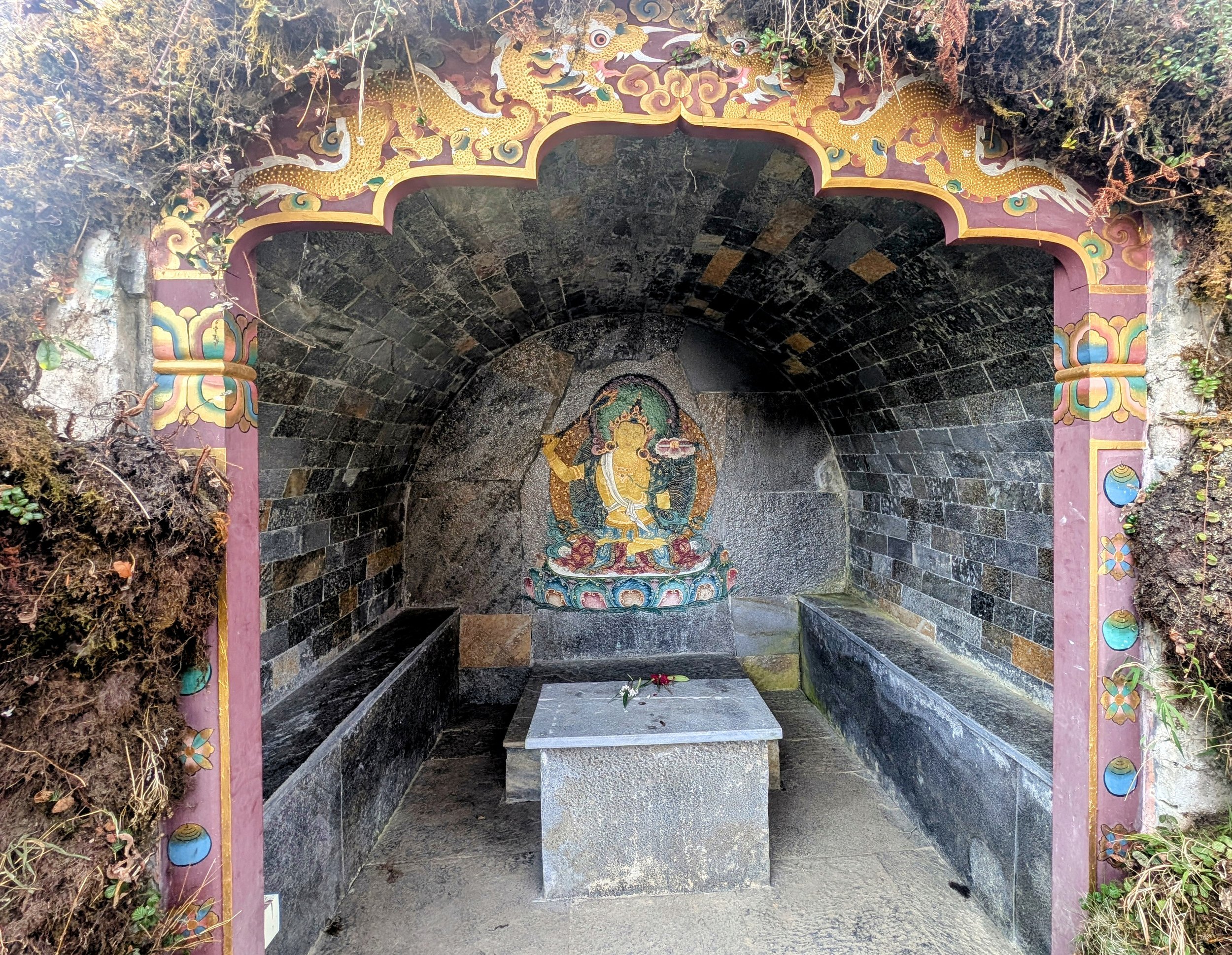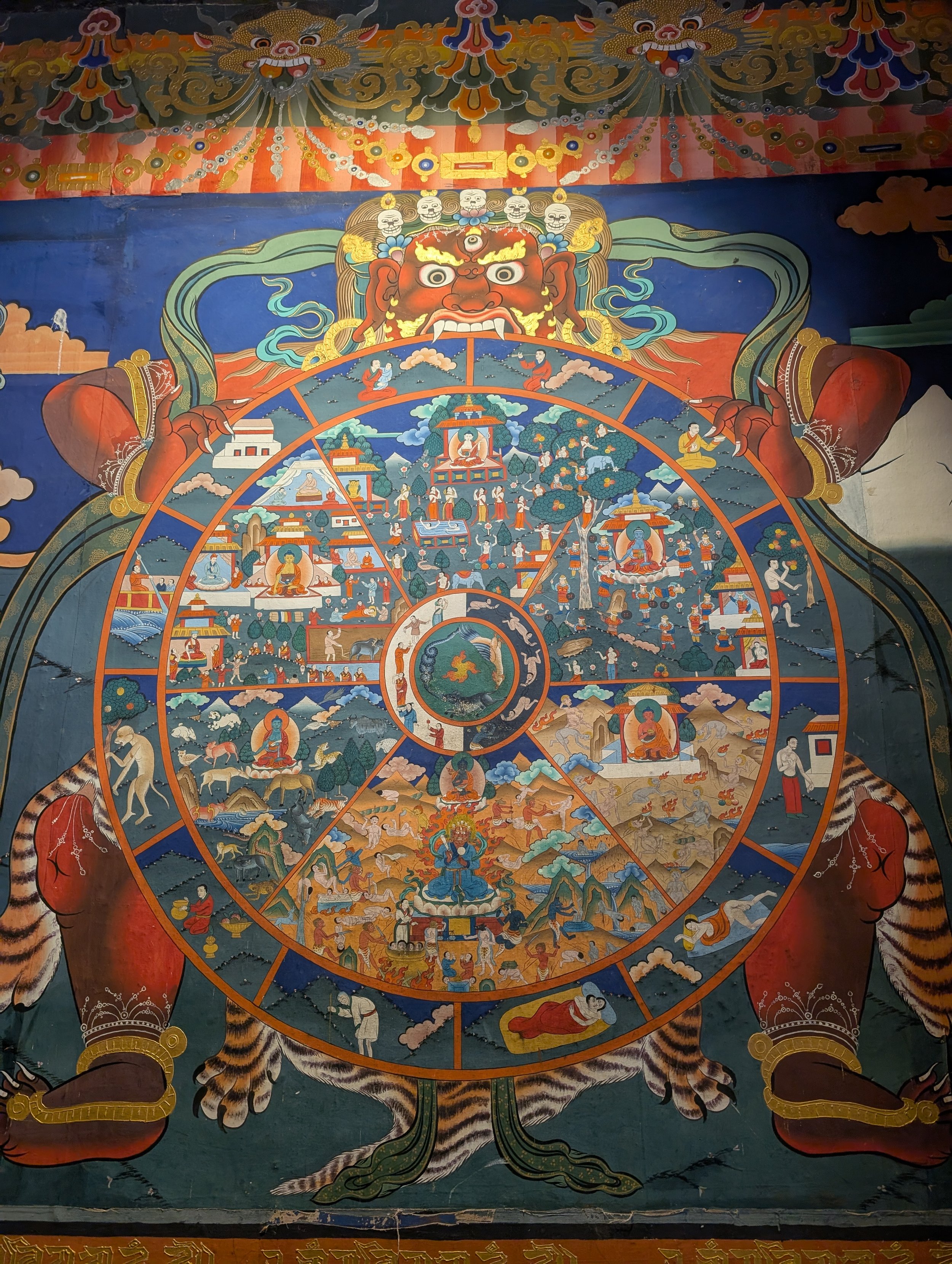Bhutan
View across the valley to Tiger’s Nest Monastery (Paro Taktsang)
Bhutan is a country that was shrouded in mystery for us. A remote kingdom nestled in the Himalayas, it only opened to tourism in the 1970’s. Very aware of their position surrounded by India and China, two huge and powerful neighbors, the people of Bhutan are fiercely protective of their strong cultural traditions. Outside media was not allowed in the country until 1999. With less than 800,000 people, the kingdom relies on selling hydro-electric power to fuel its economy. They forbid climbing the Himalayan range between themselves and China preferring to keep a strong geographic and mental barrier between themselves and the giant in the north who has encroached on their borders in the recent past.
As it is a Buddhist nation, visiting and understanding Bhutan required a deep dive into religious history, visiting ancient temples and learning how the faith is built into the fabric of Bhutanese culture.
Straight of the plane, meeting up with our guide Karma and visiting our first Buddhist monastery
Everywhere in Bhutan we saw these small clay stupas, called tsatsas. Made with the ashes of deceased loved ones mixed in the clay, they are created as a form of remembrance and to generate merit for the deceased's better rebirth. They are usually placed in larger stupas or at sacred sites.
Bhutan had some of the most exquisite and unique architecture of anywhere we had been. Intricate wood work, with detailed and colorful painting adorned every building from simple homes and markets to magnificent temples and monasteries
Buddhist stupa - a building which houses an important religious relic. Stupas can be elaborate like this one or simple rock and brick structures. We learned the proper way to visit, walking three times clockwise around the building.
Entrance gate to the giant seated Buddha on the hill above the capital, Thimphu
Posing with the giant Buddha - in Bhutan they did not follow the same courtesy as in Sri Lanka - it was OK to pose with your back to Buddha. We are wearing our white scarves gifted to us upon arrival by our guide, Karma.
Our visit to Bhutan was short - a mere five days- mostly for financial reasons. Tourism is highly regulated and very expensive. On top of normal expenses there is a government fee of $100 USD per person per day. And you are required to travel with a guide. Likely we could have found a cheaper option with a larger tour group, but we signed up for a short private tour with a guide and driver. Our total cost was just under $3000 - $1000 in tourism tax, then $400 a day for guide, driver, accommodations, food and entrance fees. In the end we enjoyed our time with our guide and learned a lot more than we would have in our normal way of traveling on our own. It was a strange and luxurious experience being driven from place to place without having to think or navigate next steps.
Our five day mini-tour of Bhutan
Takin - the national animal of Bhutan and unique to its high mountain regions - we saw them visiting a national reserve for their preservation.
To us it looked like a cross between a buffalo and a yak, this was a small one, some of the males were fully as big as a full grown buffalo
A mountainous nation, Bhutan’s population primarily lives in a series of valleys. Each valley is typically protected by an ancient fort or dzong. These fortified buildings provided a dual purpose - a monastery for the region’s religious leaders and an administrative center for the government.
Bhutan is officially a kingdom and pictures, posters and billboards of their much revered family of monarchs are a common sight. King Jigme Khesar Namgyei Wangchuck and his wife have three young children. Our guide explained that he had great admiration for the king who dispersed payments from his personal accounts to unemployed people during COVID and is implementing a vision for the future of Bhutan which involves building infrastructure to encourage business development with its southern neighbors. There is also a prime minister appointed by the King. The prime minister leads the executive branch of the government and typically is the leader of the party who wins the most electoral votes in parliament.
One of the oldest dzongs on the hill above Thimphu - Druk Wangditse Lhakhang
One of the most common words seen throughout Bhutan - druk - means dragon. The Bhutanese name for the country - Druk Yul - translates as “land of the thunder dragon.” Stories about ogres, dragons and evil spirits being conquered by Buddhist heroes are woven into the national folklore.
Beautifully painted prayer wheels were a common site
Sunlight hitting the gorgeous painted woodwork
Watching the national sport - archery
Our driver and guide - dressed in the traditional clothing of Bhutan
Traditions felt strong in Bhutan. Even in the two big cities, Thimphu and Paro, most of the people were wearing the beautiful traditional clothing and fabrics of the country. At temples and stupas, worshippers circled the buildings with prayer beads and personal prayer wheels, chanting mantras. Families with young children and groups of teenagers prayed in the shrines.
More beautiful architecture - and always the mountains behind
Site of 108 stupas. The number 108 is important in Buddhism as it represents the number of earthly desires or passions that Buddhists strive to overcome on their path to enlightenment. These stupas were built to commemorate the lives of Bhutanese soldiers lost in fighting rebels from India in 2003.
Small caves built for contemplation
Traditional village home. Despite being a very modest country, it was common to see phallic symbols painted on walls - representing a desire for fertility.
Running into a snake on a trail across a rice paddy - we later figured out it was harmless
The decoration on the homes was just exquisite, even on the more recently constructed houses
Artist at work on traditional religious painting
More fertility painting
Dawn could not stop taking photos of the painted wood
Prayer wheels at the fertility temple Chimi Lhakhang (Andy is not hoping for more children). An important pilgrimage site, Buddhist families from all over the world come to pray for children. Our guide Karma, showed us the book of thank you notes from grateful parents.
The insides of the temples and shrines were incredibly ornate but no photos were allowed. Common sights were gold statues of Buddhas and other historical figures - Ugyen Wangchuck, the man who united the tribes of Bhutan in the late 19th century and Guru Padmasambhava, the man who brought Buddhism from Tibet in the 8th century. Often there would be at least one or sometimes many monks chanting mantras and offering blessings. Our guide Karma explained that every temple contained three elements representing mind, body and speech. The mind was represented by statues of Buddha, the body was the temple building and the speech was the shelves of books with printed mantras and prayers.
Punakha Dzong - one of the largest fortresses, still actively housing both a monastery and government administrative offices, constructed in 1637.
Entrance with paintings depicting important Buddhist stories
Dawn still taking those pictures!
And Karma took one for us too
Going for a walk along what used to be the national highway connecting Thimphu and Paro. The paved highway was only completed in 1962.
As part of our tour package we requested budget accommodations. Even the budget levels hotel were lovely.
As part of our tour we visited the two biggest cities in Bhutan - Thimphu, the capital, and Paro where the international airport is. Both towns were pleasant to walk with lots of tourist shopping activities, featuring local arts and paintings, statues and carvings related to Buddhism. Thimphu was larger and more modern, Paro was smaller and felt more traditional. Both cities felt completely safe for tourists and had a relaxed atmosphere. Despite the rows of souvenir shops, there was no hard core sales tactics.
Kyichu Lhakhang one of the oldest temples in Bhutan, built in the 7th century - outside Paro
Prayer wheels outside Kyichu Lhakhang
Inner courtyard of the temple
Spinning the giant prayer wheel
Ringpung Dzong on the hill above Paro
Climbing the steps to the head religious and government administrative offices of the Paro region. Karma is wearing his white sash depicting him as a “common man” as opposed to a religious or government official.
Detailed painting of the Buddhist “wheel of life” depicting the six realms of beings in Buddhism - the bottom three, not so good, the top three something to strive for. Human beings and enlightened ones are in the top half, animals and evil spirits in the bottom.
Inner courtyard of Ringpung Dzong
Our final day in Bhutal we climbed the hill to Tiger’s Nest monastery, or Paro Taktsang. One of the most iconic sights and holiest religious centers in the country, it was worth the work to get there.
First views across the hill
Getting closer!
As was the custom, no photos were allowed inside but Karma pointed out the significance of the various shrines and temple rooms and told us the stories behind the creation of the monastery, bringing it to life. The story goes that Guru Padmasambhava brought Buddhism to Tibet here, flying on the back of a tigress and landing here to meditate and conquer the ogre terrorizing the valley
Also on our last day, we asked to go to a local restaurant instead of the tourist centered restaurants we had been going to. It was a unique experience but a little challenging for Andy who hates vegetables. Sometimes there is a reason tourist restaurants serve different food to tourists.
Beautiful door in Paro
Our last hotel in Paro
Well that was our second journey without the truck this month - rare for us. Bhutan makes it almost impossible to bring a foreign vehicle in (we know an Australian couple who managed it but they later found out they should not have been allowed) and the requirement for a guide made the decision to fly in and out easy. It was one of our most expensive countries, but in our brief visit we did feel like we got a good sense of the culture, geography and history of the country. Back to the truck now, planning some trekking in Nepal. Thank you for reading!













































